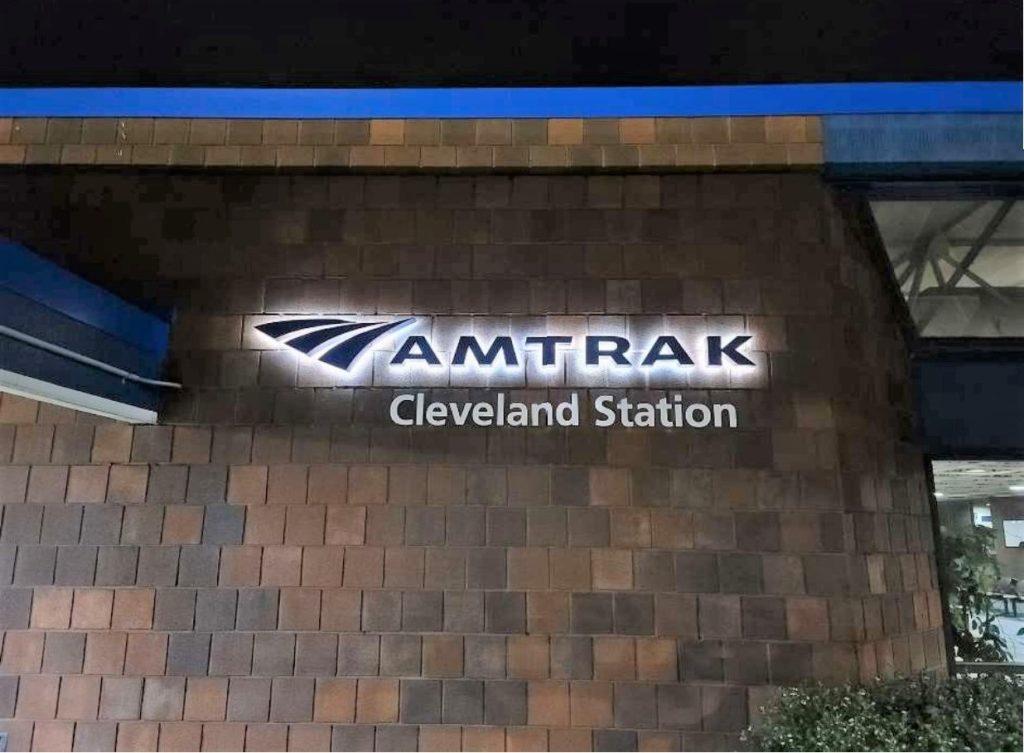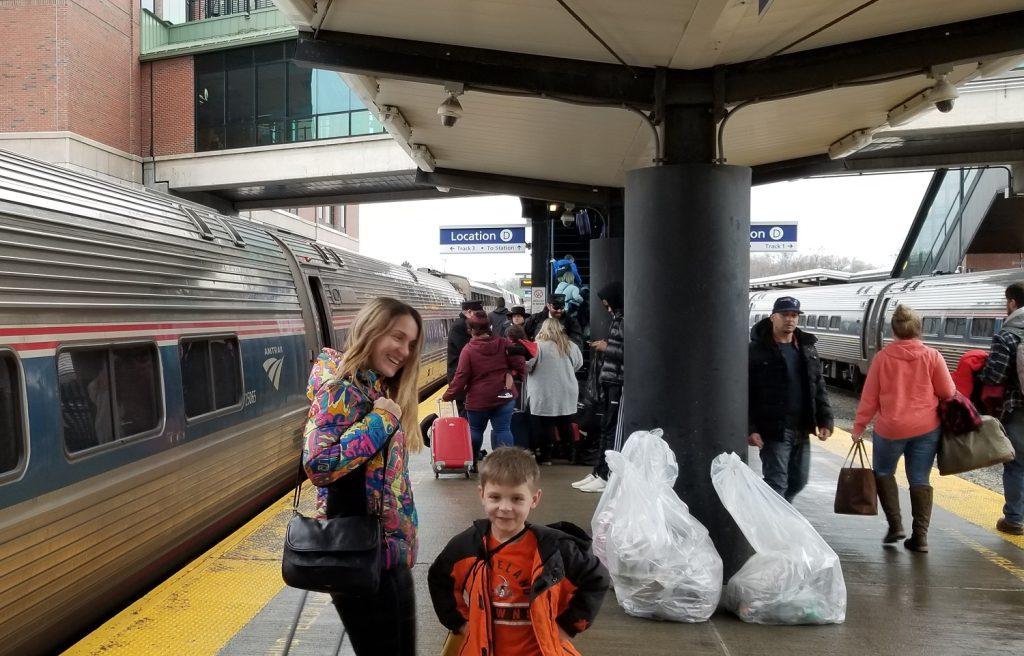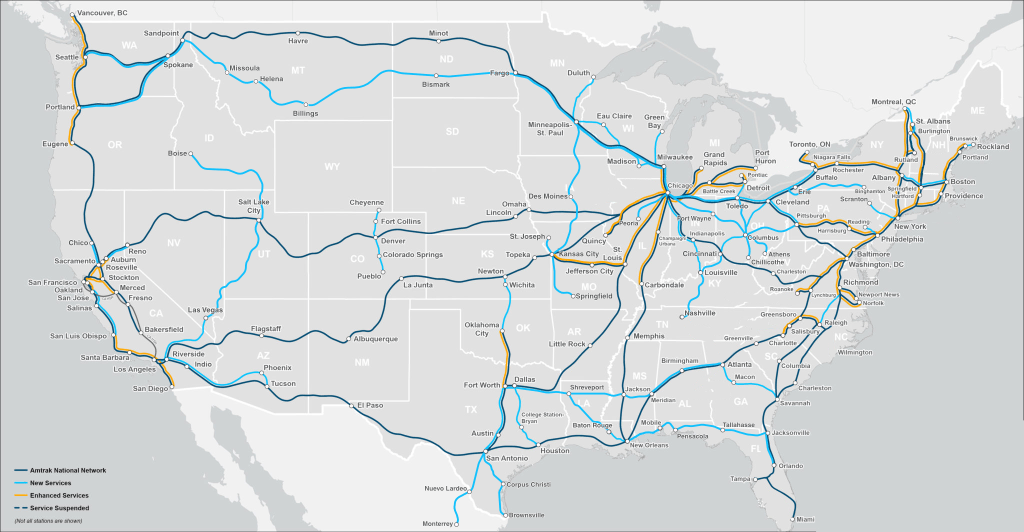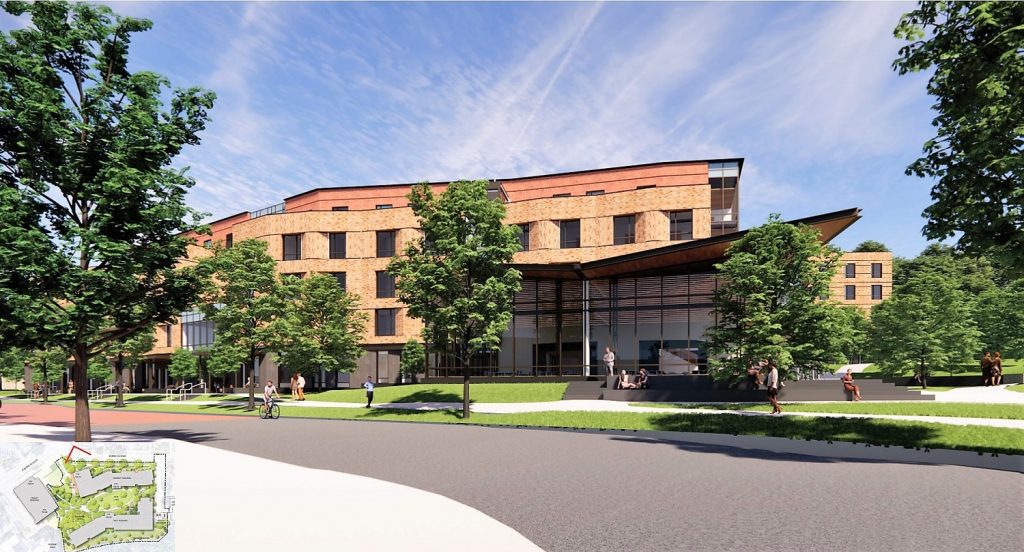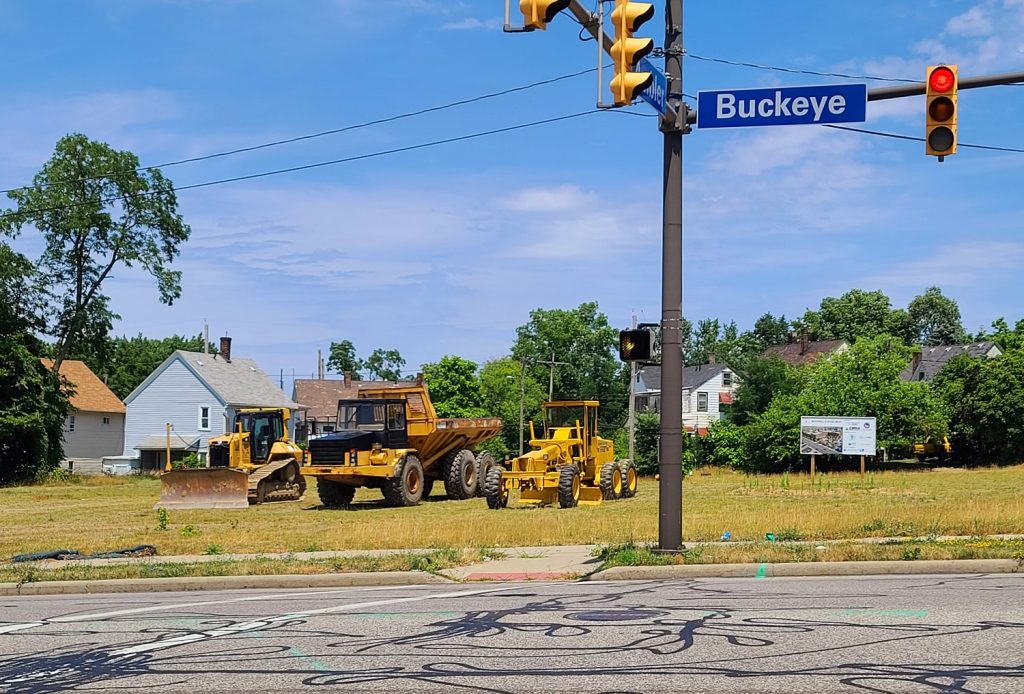Regional governments, Amtrak may lead expansion
Several initiatives that are in their early stages may instigate passenger rail expansion to Cleveland before the state of Ohio decides to get on board. That could be welcome timing considering the Federal Railroad Administration will solicit applications next week for funding to begin the process for developing new and expanded passenger rail services.
Opportunities are coming together for a city that has waited for decades for the state to get on track while neighboring states like Michigan, Pennsylvania and New York are setting up green signals to further improve their train services. Indeed, federal law since 2008 has put the onus on rail service expansions entirely on states which purchase services from the national passenger railroad Amtrak. For 50 years, the State of Ohio has studied and talked about expanding train services on several routes including the so-called 3C Corridor linking Ohio’s biggest cities — Cleveland, Columbus and Cincinnati.
But since trains can’t run on tracks made of study documents, Ohio has been left at the station while other states enjoy tens of millions of dollars in economic benefits from having dozens of their smaller cities linked to the biggest cities in those states, Amtrak says. The Ohio agency responsible for leading passenger rail development, the Ohio Rail Development Commission (ORDC), is required by its enabling legislation to pursue 3C Corridor first. All of those past studies showed 3C’s ridership would be among the highest of any new-start, state-sponsored passenger rail service in the country since Amtrak began in 1971. And, like any transportation service or infrastructure, it would require ongoing state financial support.
Ohio has balked at spending any of its own money and, in 2011, gave back $400 million in federal funds to pay the full construction cost of improved tracks, signals, stations and 79 mph trains that would have linked Ohio’s 3Cs plus Dayton and several other smaller cities en route. Ohio also turned back $15 million in federal planning funds that would have made the 3C route eligible for federal dollars to further improve tracks, signals and road crossings to safely raise train speeds to 110 mph.
Since then, states like Illinois, Michigan, New York, Pennsylvania and even the northwest corner of Indiana have invested hundreds of millions of dollars in their train services, including boosting train speeds from 79 mph to 110 mph. In Pennsylvania, its Keystone East line linking Philadelphia and Harrisburg has seen speeds increased to 125 mph. Ditto for Florida where a privately run service called Brightline, sustained in part by real estate developments at stations, linking Miami and Orlando will open in 2023 new 110-125 mph route sections over which hourly trains will operate.
Then, prior to President Joe Biden signing the Bipartisan Infrastructure Law (BIL) last year, Amtrak released a proposed 15-year passenger rail expansion plan called Amtrak Connects US. Among its visions, it offered the addition of several daily trains on each route out of Cleveland to Toledo/Detroit, Buffalo/New York City, Pittsburgh/Philadelphia and Columbus/Cincinnati. Amtrak said the expansion would turn downtown Cleveland’s lakefront Amtrak station into a mini-hub with up to two dozen trains a day and bring more than 1 million people per year to the central business district to get on and off its trains.
A new opportunity
With the passage of the federal BIL, also called the Infrastructure Investment and Jobs Act (IIJA), passenger rail development programs are authorized to be funded at $66 billion over five years. While most of that money will go to the Boston-New York-Washington DC Northeast Corridor and to modernize existing services nationwide, there will be about $12 billion available to states to expand and improve their train services. Amtrak has told rail-phobic states like Ohio it is willing to support up to 100 percent of the operating costs of new state-sponsored services over the first five years while the new services stabilize and become more familiar to a traveling public that hasn’t been accustomed to having driving-competitive choices.
According to Gov. Mike DeWine’s office, ORDC was tasked last summer with studying the feasibility of Amtrak expansion and how much funding Ohio might be expected to provide after Amtrak’s funding contribution expires. However, ORDC, a semi-autonomous commission under the Ohio Department of Transportation (ODOT) umbrella, has not hired any independent experts to provide its own numbers and is instead relying on Amtrak’s data.
“We produced some numbers for ORDC so they and ODOT are still discussing what those numbers will look like,” said Marc Magliari, senior public relations manager at Amtrak. “If they decide to move forward, there’s now study money in greater availability including for Service Development Plans and NEPA (National Environmental Policy Act clearance) documentation.”
Products of those planning actions could allow a proposed new or improved route into Ohio to be eligible for federal dollars for construction of new passing sidings, expanded stations and road crossing safety as well as for up to three years of operations after which non-federal funding would need to be found to sustain the rail service. Pennsylvania is already doing that through a partnership announced last summer with track-owning freight railroad Norfolk Southern to double passenger service on its Keystone Corridor from Harrisburg to Pittsburgh. More states and regions will likely start similar project development processes soon.
“FRA plans to issue a Notice of Solicitation and Funding Opportunity within the next week,” said FRA spokesman William Wong. “The notice will be published in the Federal Register and will include instructions for submitting applications to join the program, project eligibility requirements, and the application deadline, among other information. It will also note types of projects that may be given special consideration.”
Going the distance
But not everyone’s waiting for Ohio to jump on board this latest funding opportunity. Metropolitan planning organizations (MPOs), regional planning commissions (RPCs), municipalities, nonprofit advocacy groups in Ohio and departments of transportation in surrounding states are stepping up to the throttle to get Ohio’s train moving. And while an earlier version of the transportation law passed by the U.S. House of Representatives (before the U.S. Senate removed it) would have made it easier for Amtrak to expand services without having state partnerships in place first, there is a scenario whereby Amtrak could expand service in Ohio on its own.
Magliari noted that the Federal Railroad Administration (FRA) is studying the restoration of long-distance routes Amtrak discontinued, operates less than daily or should have more than just one daily train on it. He noted that discontinued Ohio routes such as the New York-Kansas City National Limited (Columbus’ last Amtrak service in 1979) could be addressed, as might the improvement of other National Network routes like the New York-Cincinnati-Chicago Cardinal which has operated less-than-daily since 1981. The study might also include improving or enhancing daily routes like the New York/Boston-Cleveland-Chicago Lake Shore Limited or the Washington-Cleveland-Chicago Capitol Limited which serve Ohio in the overnight hours.
“Section 22214 (of the BIL) states that the results of the study will be submitted to Congress no later than November 2023,” Wong said. “This information can then be used by legislators and other entities, such as states and transit agencies, for future planning activities related to restoring discontinued Amtrak long-distance routes or increasing the frequency of service on routes where there is currently non-daily service. Section 22214…also states FRA may evaluate potential new Amtrak long-distance routes in the study.”
When that study is done, additional federal funding may be recommended for Amtrak to provide the most cost-effective restorations and expansions. Magliari speculated the study results may be of interest to Ohioans given the number of routes that would likely be included.
“I wouldn’t close the door to that,” he said.
For those unwilling to wait
For short-distance (under 750 miles) routes that fall under the responsibility of states to sponsor, things get a little more complicated for Ohio. States have to work together, assign responsibilities and coordinate funding for interstate services that cross state lines. That gets even more difficult in Ohio which has no ongoing passenger rail development program. Worse, ORDC’s enabling legislation says it should pursue the intrastate 3C Corridor first, practically knocking itself out of a leadership role for developing other routes, especially interstate ones.
Even there, ORDC has not yet responded to an open invitation by the FRA to submit 3C Corridor or any other routes to an inventory of existing or potential passenger rail lines, called “corridors,” nationwide so they could be eligible for funding for planning and development. That inventory is the Corridor Identification and Development Program to which numerous Ohio routes have been submitted, none by the state itself.
Instead, MPOs (which administer federal transportation funds for urbanized areas) in a half-dozen Ohio cities plus in Erie, PA as well as the Michigan Department of Transportation (MDOT) have submitted numerous Ohio routes to the FRA’s Corridor ID program. Cleveland Mayor Justin Bibb, along with mayors of all other major cities in Ohio, plus economic development organizations like the Downtown Cleveland Alliance have all expressed support for expanding passenger rail.
“ORDC has no staff charged with the responsibility of passenger rail so MPOs and RPCs are doing more to advance passenger rail,” said Stu Nicholson, executive director of the nonprofit advocacy association All Aboard Ohio in Columbus which recently wrote to Gov. DeWine urging the creation of a cabinet-level department to administer passenger rail and public transportation programs. “I’m glad ORDC and Amtrak are working together but how long does it take to get this done? They’ve been working since last summer. ORDC hasn’t applied for any grants nor given any indication that it’s going to. We need more transparency of what they’re doing.”
ORDC responded that they are working with Amtrak and others, including having conversations with neighboring states, like the New York State Department of Transportation (NYSDOT) and the Pennsylvania Department of Transportation (PennDOT) which was news to the MPOs and to All Aboard Ohio.
“The nature of the conversations was to discuss each state’s positions regarding the Amtrak Connect US plan,” said ORDC Public Information Officer Wende Jourdan. “As you may recall, Gov. DeWine requested that ORDC engage with Amtrak on the routes in Ohio identified in the plan. ORDC reached out to the parties as part of our due diligence process in response to the governor’s request. These conversations were high level in nature. NYSDOT and PennDOT have submitted expressions of interest, so please feel free to reference those formal letters (to FRA) to identify each state’s route priorities.”

A month prior to his election in 2020, soon-to-be President Joe Biden spoke at the Cleveland Lakefront Amtrak Station about his plans for improving the nation’s infrastructure, including passenger rail (Ideastream).
Of Wolverines, Empires and Keystones
While MDOT submitted to the FRA’s inventory an extension of its Chicago-Detroit Wolverine Corridor to Toledo and Cleveland, or completely new, separate service to those Ohio cities, neither NYSDOT or PennDOT included references to Ohio extensions of Amtrak routes they sponsor. However, in emails to NEOtrans, spokespersons for both states said they have begun discussions with Ohio transportation officials at the state and regional levels about extending to Cleveland a New York City-Buffalo Empire Service train and a New York City-Pittsburgh Keystone Service train. All three of those expansions were in the Amtrak Connects US vision.
“Preliminary conversations regarding a potential Amtrak Empire Service extension that involve the Ohio Rail Development Corp. (sic), NYSDOT, and PennDOT are in the very early stages,” said Glenn Blain, NYSDOT’s assistant director of communications.
“PennDOT periodically works with our neighboring states to advance transportation that benefits Pennsylvanians,” said PennDOT Press Secretary Alexis Campbell. “There are upcoming opportunities by the Federal Railroad Administration that may provide funding for new or expanded passenger rail service, and PennDOT staff have discussed at a high level what options may exist for connections beyond those that exist today, including connections to neighboring states. At this time, there haven’t been any concrete discussions on specific alignments, services, or future funding.”
In August, Greater Cleveland’s MPO, the Northeast Ohio Areawide Coordinating Agency, submitted to the FRA the following routes to be eligible for federal planning and development funds:
• The Cleveland-Toledo-South Bend-Chicago corridor
• The Cleveland-Buffalo-Rochester-New York City corridor
• The Cleveland-Pittsburgh-Philadelphia-New York City corridor
• The Cleveland-Pittsburgh-Washington, D.C. corridor
• The Cleveland-Toledo-Detroit corridor
NOACA didn’t submit the 3C Corridor because it expected the ORDC and/or other MPOs to add it. While ORDC hasn’t yet submitted it, MPOs in Mansfield, Columbus, Dayton and Cincinnati have. One year ago, NOACA and other affected MPOs requested $2.56 million from the FRA for a $3.2 million service development plan for Cleveland-Chicago Amtrak service and rail freight expansion. Although it didn’t win the funds in that round, NOACA expects to try again and go after planning funds for the other routes as well.
“NOACA is diligently working to ensure that the Amtrak Connects US plan is implemented as it relates to Cleveland, especially focusing on Cleveland as a mini-hub with increased frequency, improved schedules and new service,” said Grace Gallucci, NOACA’s executive director and CEO. “We are collaborating with partners across the Chicago to Cleveland to New York/DC corridors to leverage the opportunity presented by the IIJA funding for passenger rail.”
NOACA has aggressively pursued partnerships with other states that may be willing to submit federal funding applications for expanding train services they sponsor. Despite the fact that the eligibility rules have changed in favor of MPOs in terms of who can apply for planning and development funds, the FRA still prefers to work with states. However, MPO staff time can count as a local contribution to a federal grant request that requires at least 20 percent of planning costs to be borne locally.
If ORDC won’t seek passenger route expansions from neighboring states, either because it must pursue 3C first or because it won’t pursue passenger rail expansion at all, the possibility that an MPO like NOACA would partner with a neighboring state may be the only hope for adding more Amtrak trains to Cleveland for the foreseeable future. That apparently wasn’t something ORDC had considered until now.
“ORDC was unaware of NOACA’s conversations with other states until recently so we cannot comment on their actions or intentions,” Jourdan said.
END


